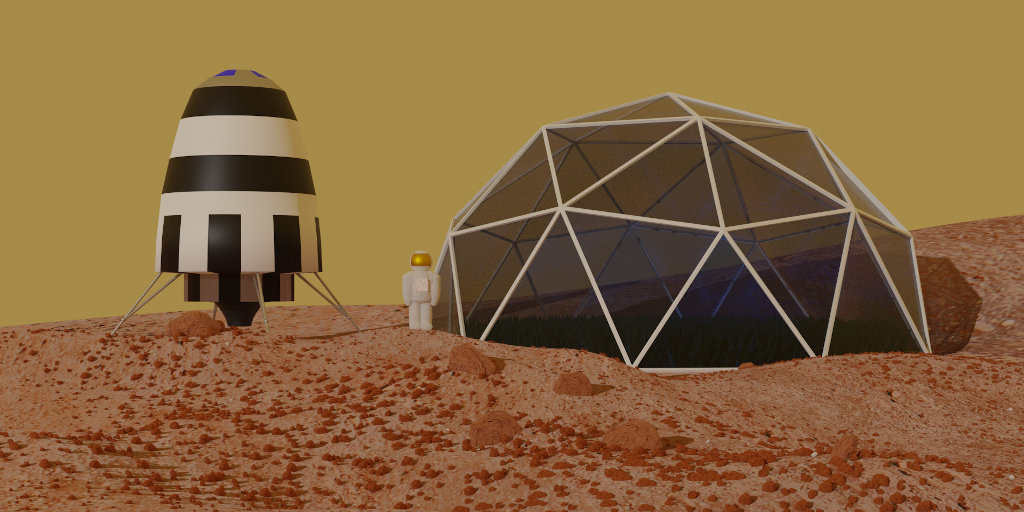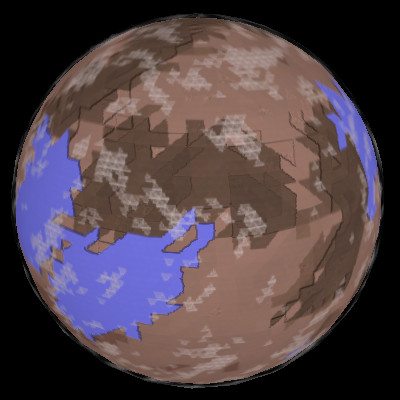Small Colony, Small World

The current focus of WorldGen are colonies on small, barely habitable worlds similar to Mars. These are categorised as Arean worlds in the Planetary Classification List, members of the Geo Cyclic class in the Dwarf Terrestrial Group. I’m not actually fond of the Geo Cyclic definition, since it implies that these worlds go through wet/dry cycles. I can’t find anything that suggests that a world such as Mars may actually do this – instead they’re likely to simply dry up and die given a few billion years. I’m not quite sure why the original PCL included this as a definition, but I’m keeping it now until I come up with a better name for the class.
An Arean world comes out of its proto- stage as an Eo Arean dwarf planet, still cooling, with a thick inhospitable atmosphere and possibly moisture in the atmosphere. As they cool and lose atmosphere, seas will form as water vapour condenses and cometary strikes in the early solar system add more water to the planet.

Such worlds cool a lot quicker than their larger Gaian cousins, and will rapidly reach the Meso Arean stage, where they still have enough atmosphere and heat to sustain liquid water on their surface. In some cases, they last long enough for basic life to arise, possibly even land based life, though ironically by the time such has happened the world is well on its way towards becoming inhospitable. It’s a race between life evolving and the planet dying.
Beta Ene I is a drying desert world that is losing its atmosphere to space almost as quickly as slowing geological processes are replenishing it. There are small seas of liquid water dotted around the world though, but these will be gone in a hundred million years.
Beta Ene I has evolved multicellular life, the presence of oxygen in the seas allowing the rapid expansion of life forms. Single celled organisms known as Prokaryotes are the dominant form of life on Beta Ene I. They generally cluster near the surface of the seas, seeking sunlight and any other nutrients available.
— Beta Ene I
So most Meso Arean worlds will have some form of native life, though it has rarely evolved to the point where it has left the seas. There will be an atmosphere of sorts, though it may not be entirely breathable.
Such worlds aren’t ideal for mass colonisation, but they’re a reasonable place for a small colony that wants some level of autonomy in a place that isn’t too inhospitable, especially if the world is a good source of resources. Unfortunately, such worlds rarely are due to having a low metal content so they are often colonised for being the best of a bad set of choices.
Small Colony
A Small Colony often has a population of several hundred thousand, which will consist of multiple settlements across the planet. There will be a number of different styles of such a colony, depending on the habitability of the world in question.
Most Meso Arean worlds are considered habitability class II or III. Class III worlds are difficult to live on and may require a breathing mask to provide sufficient levels of oxygen, but otherwise require no special protective clothing. Habitability class II worlds aren’t ideal for long term survival, but someone could survive naked with no special equipment for several days.
Class III worlds will normally require domed or subterranean habitats, sealed off from the external environment. Most of the food production will be handled either within large (usually automated) greenhouses, or on intensive farms using local terraforming techniques to ensure the land can continue to produce a decent harvest.
The world of Vymido Minor Alpha I is a hostile place, and conditions on the surface aren’t helpful to human survival. Most of the settlements of this planet are covered by huge glass domes that provide environmental control for the buildings clustered inside. Most settlements consist of a handful of interconnected domes, joined by surface tunnels protected by airlocks. Large airlocks on the outer walls provide access to the surface.
— Vymido Minor Alpha I
Though the technology level of the colony will normally be around 6 (early 20th century), the available level of technology will usually be higher. Automation will generally be used quite heavily, especially in the agricultural aspects of the colony, and high tech consumer goods are generally present, though they will be limited by practicality more than anything.
Starports
The standard starport for a small colony is a Domed Star Port, with the addition of a Small Orbital if the port is a class C. Most settlements won’t have the facilities to cater to craft coming down from orbit, though any small craft capable of landing in a dirt field won’t be stopped. Depending on the government and local laws, it may be yelled at and threatened with criminal prosecution and/or arrest of the crew, but such worlds rarely have much in the way of planetary defence – especially away from the main space port.
The low port often provides a gateway to the rest of galactic culture, so will be a good place to find people looking to get off world – for one reason or another. The harsh realities of such colonies often mean that local job prospects are limited for those growing up here.
The planet will have global satellite coverage, providing weather, geological and communication services to the colony.
Governments
Anarchy and Communist are common government types for such colonies, though some (especially the larger ones) may be Democratic or some form of Corporate or Bureaucratic dictatorship (according to where the colony funding came from). Corporate worlds will generally have better access to technology, since the corporation wants to maximise the chance of colony survival and growth.
There is little if any governing body on Iwesy I. Instead, the settlements have worked out a scheme of enlightened self interest based around a gift economy where they police themselves and help each other. Social standing is based on how much each settlement has been perceived to give away to others.
— Iwesy I
As with other small planetary settlements, Anarchy can mean anything from a functioning libertarian culture to the collapse of society. The latter will normally be given an Amber code.
The stricter societies may have a black market, which often has links through the space port. Such are always on the lookout for smaller trade ships which would be willing to risk trade in restricted goods.
Such worlds are self sufficient enough to not warrant large regular shipments of goods, but are always on the look out for smaller amounts of unique or special luxuries or items, so can be a good destination for free traders.